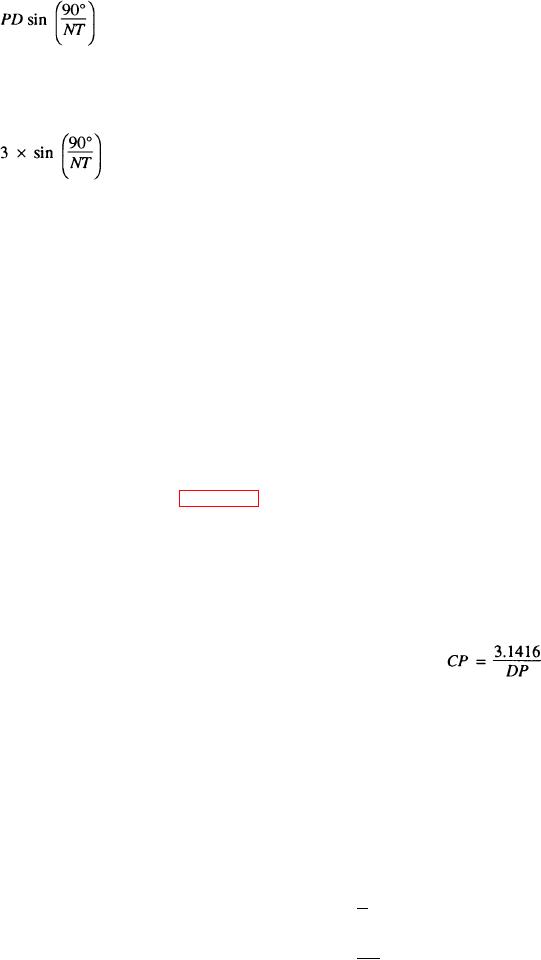3. Drill and bore to the required size (within
The formula to find the chordal tooth thickness is
tolerance).
tc =
4. Remove the blank from the lathe and press it
on a mandrel.
5. Set up the mandrel on the milling machine
For example,
between the centers of the index head and the
footstock. Dial in within tolerance.
7. Select a No. 5 involute gear cutter (8 pitch) and
tc =
mount and center it.
8. Set the index head to index 24 divisions.
= 3 sin 345″
9. Start the milling machine spindle and move the
table up until the cutter just touches the gear
= 3 0.0654
feed handwheel to zero, then hand feed the
table up toward the cutter slightly less than the
whole depth of the tooth.
= 3 0.1962 inch
10. Cut one tooth groove. Then index the work-
piece for one division and take another cut.
Check the tooth dimensions with a vernier gear
(NOTE: Mathematics, Volume II-A, NAVEDTRA
tooth caliper as described previously. Make the
10062, and various machinist's handbooks contain
required adjustments to provide an accurately
information on trigonometric functions.)
"sized" tooth.
Now set the vertical scale of the gear tooth vernier
11. Continue indexing and cutting until the teeth
caliper to 0.128 inch. Adjust the caliper so the jaws
are cut around the circumference of the
workpiece.
the reading on the horizontal scale is 0.1962 inch, the
When you machine a rack, space the teeth by
tooth has correct dimensions; if the dimension is
moving the work table an amount equal to the circular
greater, the whole depth (WD) is too shallow; if the
pitch of the gear for each tooth cut. Calculate the circular
reading is less, the whole depth (WD) is too deep.
pitch by dividing 3.1416 by the diametral pitch:
Sometimes you cannot determine the outside
diameter of a gear or the number of teeth from available
information. However, if you can find a gear dimension
and a tooth dimension, you can put these dimensions
into one or more of the formulas in Appendix II and
calculate the required dimensions.
You do not need to make calculations for corrected
addendum and chordal pitch to check rack teeth
dimensions. On racks the addendum is a straight line
MACHINING THE GEAR
dimension and the tooth thickness is one-half the linear
pitch.
Use the following procedures to make a gear with
the dimensions given in the preceding example:
1. Select and cut a piece of stock to make the
blank. Allow at least 1/8 inch excess material
on the diameter and thickness of the blank for
A helix is a line that spirals around a cylindrical
cleanup cuts.
object, like a stripe that spirals around a barber pole.
2. Mount the stock in a chuck on a lathe. At the
A helical gear is a gear whose teeth spiral around
center of the blank, face an area slightly larger
the gear body. Helical gears transmit motion from one
than the diameter of the required bore.
shaft to another. The shafts can be either parallel or set
14-5






